|
Full resolution versions of wildflower photos available on Flickr. 
NPS Photo Aster, AlpineOresostemma alpigenum A widespread flower in drier meadows and stony slopes (common in the Sunrise area). Distinguished by a single flower head per stem, with a few small, narrow leaves along stem. 
NPS Photo Aster, CascadeEucephallus ledophyllus Though the purple flowers are similar to alpine aster (Oresostemma apligenum), this plant is marked by multiple flowers on each stem, not just one, and also grows to be much taller, reaching 24 inches (60 cm) high. Leaves are hairless on top, woolly underneath, and smaller lower on the stem. Common in subalpine meadows above 5,000 feet (1,524 m). 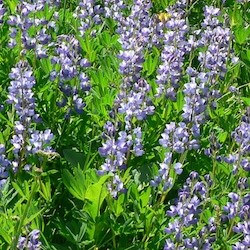
NPS, Steve Redman Broadleaf LupineLupinus latifolius Branched, hairy stems between 12-24 inches (30-60 cm) tall, with 7-8 leaflets per leaf. Abundant in open areas and meadows throughout the park's lower elevations up to about 5,000 feet (1,500 m), where it tends to get replaced by the smaller but similar-looking subalpine lupine (Lupinus articus). 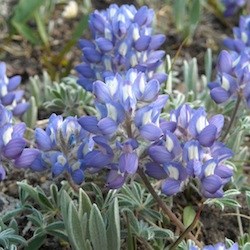
NPS, Chris Roundtree Dwarf LupineLupinus lepidus Less than 6 inches (15 cm) tall, this smaller relative of broadleaf lupine (Lupinus latifolius) grows at higher elevations in the park, generally above 7,000 feet (2,100 m). Grows to form mats with a stout, woody base, and silvery leaves with 5-7 leaflets. 
NPS Photo Harebell, CommonCampanula rotundifolia Also known as Scots bluebells, this plant has a recognizable "bell"-shaped blue-purple flower. Basal leaves are round to oval in shape, while leaves along the slender stems are narrow and linear. Prefers open talus slopes, cliffs, and streambanks up to 6,500 feet (1,981 m). 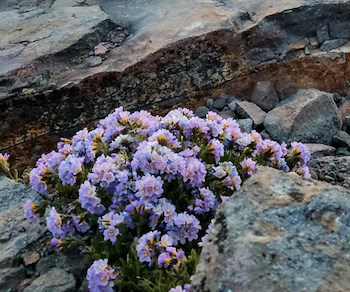
NPS/F. Madsen Photo Jacob's Ladder, ElegantPolemonium elegans 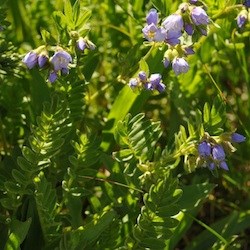
NPS Photo Jacob's Ladder, LowPolemonium pulcherrimum Leaves are mostly basal, with numerous oval to round leaflets, with stems less than 4 inches (10 cm) high. The bell-shaped flowers can range in color from white to blue, with a yellow throat. Common on cliffs and rocky ridges, between 5,000-6,500 feet (1,500-2,000 m). 
NPS Photo Jacob's Ladder, ShowyPolemonium californicum With relaxed spreading stems, this plant has leaves 4-8 inches (10-20 cm) long, with numerous oval leaflets. The terminal three leaflets usually merge at their bases. The bell-shaped flowers are blue-violet, with a yellow throat. Common in woods and meadows up to the subalpine zone, particularly around Sunrise. 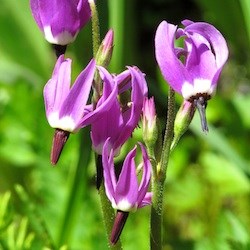
NPS, Crow Vecchio Jeffrey's Shooting StarDodecatheon jeffreyi Usually grows in clumps, with long (6-16 in/15-40 cm) basal leaves. The distinctive flowers with folded-back petals rise above the leaves on a leafless stem up to 20 inches (50 cm) tall. Common in wet subalpine meadows and along streams. 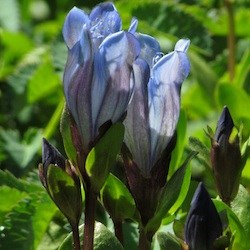
NPS, Crow Vecchio Mountain Bog GentianGentiana calycosa A single flower tops each unbranched stem, with opposite-paired leaves along stem. Common in wet subalpine meadows between 4,500-8,000 feet (approx. 1,400-2,400 m). 
NPS Photo Naked BroomrapeOrobanche unifloraThis parasitic plant has no leaves but grows from the roots of other plants (in this case buttercup suksdorfia). Host plants can also be Sedum species (stonecrops). A single flower is supported on hairy stem, 2-4 inches (5-10 cm) tall. The purple flowers are tubular with fused petals, white at the throat. The upper lip of the petals has two lobes, while the lower lip as three lobes. Broomrape can be found in the same habitats as its hosts, such as rocky cliffs along Stevens Canyon. 
NPS Photo Penstemon, CascadePenstemon serrulatus A very common plant in the park, ranging from 4,000-6,000 feet (1,219-1,828 m), along streams and in wet, rocky areas. Growing between 6-24 inches (15-60 cm) tall, this plant has unbranched stems topped with a cluster of blue-purple tubed-shaped flowers. Along the stem are pairs of toothed, lance- to oval-shaped leaves, about 4 inches (10 cm) long. 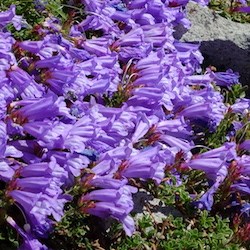
NPS Photo Penstemon, Menzie'sPenstemon davidsonii var. Menziesii Unlike the related Cascade penstemon (Penstemon serrulatus) which has tall stems, this penstemon species forms dense mats that can be up to 20 inches (50 cm) across. It has short oval leaves, less than an inch in length, along the short stems with several blue-purple flowers. Found tucked into cliff crevices and rocky slopes, between 5,000-8,000 feet (1,524-2,438 m). 
NPS Photo Penstemon, Small-floweredPenstemon procerus var. tolmiei 
NPS Photo Speedwell, AlpineVeronica wormskjoldii Similar to Cusick's speedwell (Veronica cusickii), but distinguished by hairy leaves that can be toothed. Branching from creeping rootstalk, the stems have waxy hairs, grow between 2-12 inches (5-30 cm) tall, and are topped by tiny blue flowers. Found in moist meadows above 5,000 feet (1,524 m). 
NPS Photo Speedwell, Cusick'sVeronica cusickii Spreads along slender rootstocks to form loose mats, with dark green toothless and hairless leaves along the stem. Widespread in meadows and along streams above 5,000 feet (1,500 m). 
NPS Photo Tall BluebellsMertensia paniculata Reaching about 3 feet (1 m) in height, this tall flower has several stems in a tuft with large leaves. The bell-shaped flowers appear pink when a bud, darkening to blue-purple when blooming. Found throughout the park at slighly lower elevations between 2,500-6,500 feet (760-1,980 m), in moist, open areas. 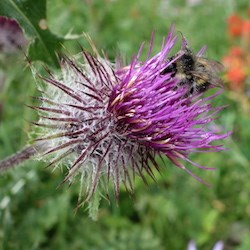
NPS Photo Thistle, EdibleCirsium edule Easily identified by its purple, fuzzy flowers and spiny leaves, thistle has stout, leafy stems, ranging from 20-80 inches (50-200 cm) tall. Found throughout the park in open forest, hillsides, and along roads. Return to Wildflower Guide |
Last updated: April 2, 2025
